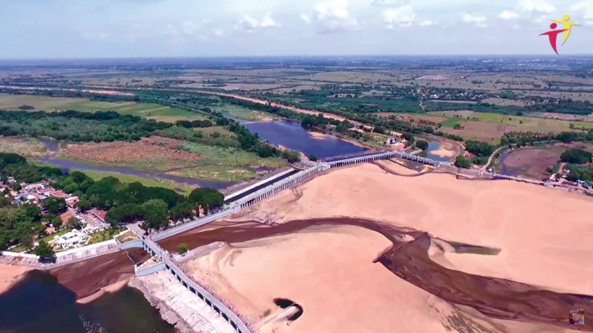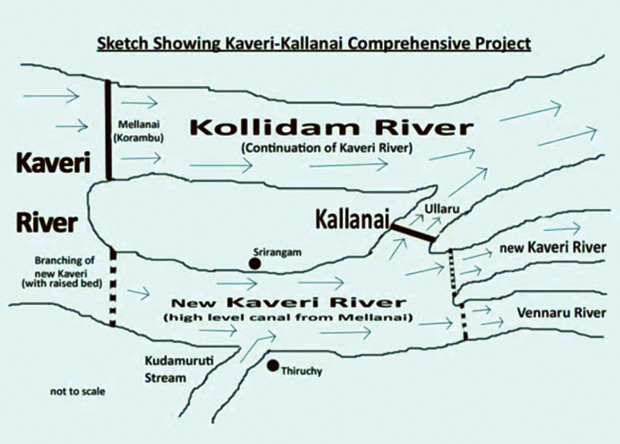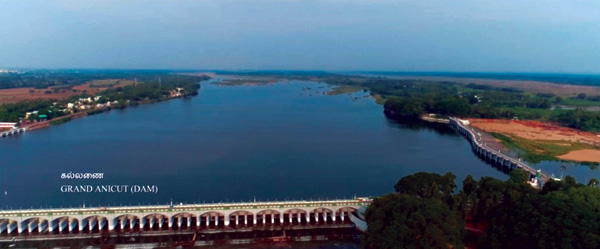Grand Anicut Canal (Kallanai)
Profile; ?>The Kallanai Dam was built during the 2nd century AD by Karikalan, a king of southern India's old Chola Dynasty and is also one of the oldest irrigation systems in the world that is still in use. Kallanai Dam is the fourth oldest dam in the world, and first in India. It is a rock-solid project that has survived 2,000 years. The purpose of the dam was to divert the waters of the Kaveri across the fertile Thanjavur delta region for irrigation via canals. The Kallanai is an anicut of unhewn stone that stands in the Kaveri parallel to the riverbank; it is more than 300 m long, 20 m wide, and 4.5 m high. It is believed that Kallanai initially irrigated about 69,000 acres, though it now irrigates close to 1 million acres (13,20,116 Acres).
The Kallanai was built to divert floods from the Kaveri branch of the river into the Kollidam branch via a short connecting stream when the water level in the river rose above its crest. The Kollidam was the wider (also the steeper, straighter, and hence faster) of the two river branches and the flood carrier. It was barely used for irrigation. Almost all of the 600,000 acres irrigated by the river in 1800 were delta lands south of the Kaveri branch. So the Kaveri branch was the lifeline for delta farmers, while the Kollidam was of little consequence for them. Once the floods were diverted to the Kollidam, they flowed directly to the sea, causing minimal damage to agriculture. The construction of the dam proved to be beneficial for the farmers of the Cauvery delta region.
Modernisation works during the British Period:
- In 1804, Captain Coldwell repaired the Grand Anicut and provided dam stones 0.69 m in height on its crest and at the same time, raised the river embankment above, ensuring additional water to the Cauvery.
- In 1829, Major Sim proposed under sluices in the Cauvery with outlets into the Coleroon to prevent the accumulation of silt in the upper reaches.
- Improvements were made to the dam in the 19th century by Arthur Cottons, a British general and irrigation engineer. The Lower Anicut built by Sir Arthur Cotton in 19th century AD across Coleroon (Kollidam), the major tributary of Cauvery, is said to be a replicated structure of Kallanai.
- The word, `Kollidam’, means a place that can contain or fit things. It can fit 300000 to 400000 Cusecs of water.
The dam is fast emerging as a tourist spot in the region. It is also home to a large variety of flora and fauna. The bird lovers can observe the birdlife in the basin and can take photographs of these beautiful creatures. The dam flaunts a magnanimous panoramic view of the water all around. You will feel relaxed and refreshed in the cool and pleasant climate in the surroundings. People mostly visit the place and have an escape from busy urban life.
In her pioneering study, Dr. Chitra Krishnan combined historical studies of old descriptions of the anicut from a variety of archives with archaeological and anthropological field surveys and original hydraulic research. This enabled her to piece together a picture of the Kallanai. Krishnan’s reconstruction suggests that the original Kallanai had some very peculiar design features: the curved shape of the masonry section, a sloping crest, and an irregular descent from front to rear.
The Kallanai dam across the Kaveri River is 329 m long, 20 m wide and 5.4 m high and is constructed from unhewn stones. The anicut was constructed on inter-locking technology without cementing material. The unique structure of the Kallanai dam involves large stones sunk in the Kaveri River to divert the water flow to the fertile delta.
HIGHLIGHTS
Country: India
Province: Tamil Nadu
Latitude : 10o 49 Longitude : 78o 49
Built: 2nd Century AD
Basin: Cauvery Basin
Sub-Basin: Vennar
Irrigated Area: 13,20,116 Acres
72nd IEC Meeting, Marrakesh, Morocco, 2021
.jpg)




.jpg)






